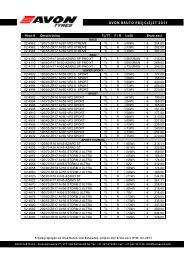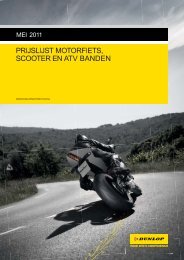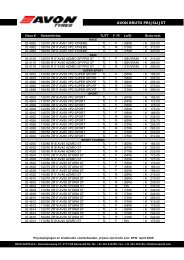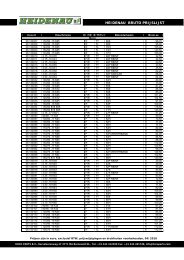You also want an ePaper? Increase the reach of your titles
YUMPU automatically turns print PDFs into web optimized ePapers that Google loves.
g. Verify that there are no leakages from the various fittings and<br />
connections. If the braking system has been bled properly,<br />
following the lever dead travel, you will feel the direct action of<br />
the fluid without any sponginess; if this is not so, repeat the<br />
bleeding procedure.<br />
N.B.:<br />
Brake fluid corrodes paints<br />
• Bleeding will not eliminate completely the air that is<br />
present in the braking system; the small residual air<br />
bubbles that remain in the braking system will be<br />
eliminated auto matically during the initial brake<br />
applications: this will result in a shorter lever travel and<br />
less elastic feeling.<br />
10.2. Notes<br />
If the lever seems too elastic following the bleeding procedure,<br />
proceed in the following manner:<br />
a. Remove one brake pad from a caliper.<br />
b. Apply the brakes several times so as to push-out the pistons<br />
about 3/4 mm.<br />
c. Push back the pistons (avoid damaging the disc and the<br />
pistons).<br />
d. Put the brake pad back into the caliper.<br />
e. Repeat the above steps on the other(s) pad(s) and/or caliper(s).<br />
f. Verify whether brake lever travel has improved.<br />
11. RUNNING-IN<br />
(BURNISH PROCEDURE)<br />
a. Except for particular instructions for specific friction materials,<br />
running-in may be done after 5 laps at average speed; at least<br />
90% of the pad surface must be in contact with the disc surface<br />
for running-in to be considered complete.<br />
b. Avoid running under power with the brakes applied; this will<br />
cause sudden temperature increases which may change the<br />
friction characteristics of the pads.<br />
c. It is suggested to use used pads for new discs and used<br />
discs for new pads.<br />
12. BRAKING SYSTEM FINAL<br />
INSPECTIONS<br />
After running a few laps, it is necessary to carry out the following<br />
checks:<br />
a. The wheels must rotate freely without any residual torque.<br />
b. There must not be any interference between disc and caliper.<br />
c. The caliper temperature must not exceed 130 °C (verify through<br />
the thermotapes of the caliper see fig. 3).<br />
13. BRAKE EXAMINATION FOLLOWING<br />
USE<br />
13.1. Fittings<br />
Verify that there are no leakages from the various components,<br />
connections, or fittings. If a leak is found on one of the fittings,<br />
either increase the tightening torque, or replace the defective<br />
component.<br />
13.2. Steel discs<br />
a. The discs must be free from cracks of any kind (either<br />
originating from the holes or from the borders) and must not<br />
show anomalous wear or scratch marks.<br />
b. Thickness of the braking surfaces cannot be reduced by more<br />
than 0.4 mm with respect to the original thickness (0.2 + 0.2<br />
mm for each of the two braking surfaces). Defective or<br />
excessively worn discs should be changed; keep in mind that<br />
when a disc has to be changed, the whole disc-bell assembly<br />
must be changed.<br />
g. Verificare che non ci siano perdite nel circuito. Se l’operazione<br />
di spurgo è stata effettuata correttamente, non si avvertirà alla<br />
leva “l’effetto spugna”, indicante la presenza d’aria<br />
nell’impianto. In quest’ultimo caso è obbligatorio ripetere le<br />
operazioni di spurgo.<br />
N.B.: Il fluido freni è corrosivo<br />
• Lo spurgo non elimina TUTTA l’aria all’interno del circuito,<br />
qualche piccolissima bolla d’aria resterà necessariamente<br />
all’interno. Queste bollicine saranno eliminate<br />
automaticamente durante la fase di primo utilizzo dei freni,<br />
come risultato si noterà un accorciamento della corsa leva.<br />
10.2. Note<br />
Qualora non si riesca ad eliminare l’effetto spugna nonostante<br />
ripetute procedure di spurgo, effettuare la seguente operazione:<br />
a. Rimuovere una pastiglia freno dalla pinza.<br />
b. Azionare la leva freno in modo da far uscire di 3/4 mm il<br />
pistoncino dalla propria sede.<br />
c. Spingere il pistoncino completamente in sede.<br />
d. Rimontare la pastiglia.<br />
e. Ripetere l’operazione descritta applicandola a tutti i pistoncini.<br />
f. Verificare l’effetto di quest’operazione.<br />
11. DISCHI IN ACCIAIO<br />
a. Fatta eccezione per alcuni specifici materiali d’attrito, il<br />
rodaggio dovrebbe essere terminato dopo circa 5 giri di pista<br />
compiuti a velocità media, quando cioè almeno il 90% della<br />
superficie del materiale d’attrito è venuto a contatto con il<br />
disco.<br />
b. Evitate di rodare le pastiglie mantenendo sia l’acceleratore che<br />
il freno azionati: così facendo si generano sovratemperature che<br />
possono portare a variazioni sostanziali delle caratteristiche del<br />
materiale d’attrito.<br />
c.<br />
Rodare i dischi nuovi utilizzando pastiglie usate.<br />
Rodare le pastiglie nuove utilizzando dischi usati.<br />
12. CONTROLLO FINALE<br />
Dopo aver percorso alcuni giri di pista, è conveniente<br />
effettuare i seguenti controlli.<br />
a. La ruota deve poter ruotare liberamente (la coppia residua deve<br />
essere quindi minima).<br />
b. Non ci deve essere alcun’interferenza tra disco e pinza freno.<br />
c. La temperatura della pinza in esercizio non deve superare i<br />
130° centigradi (fate riferimento alle thermo tapes descritte in<br />
figura 3).<br />
13. ISPEZIONE COMPONENTI DOPO<br />
L’USO<br />
13.1. Raccordi tubazioni<br />
Verificare che non ci siano perdite dai vari componenti; se ci fosse<br />
un trafilaggio dalle guarnizioni dei raccordi provare ad aumentare<br />
leggermente il serraggio del bocchettone. Se la perdita persistesse,<br />
sostituire il componente.<br />
13.2. Dischi in acciaio<br />
a. Il disco deve essere assolutamente privo di cricche (siano esse<br />
generate dai fori di pulizia pastiglie oppure dal bordo del disco)<br />
e non devono presentare alcun consumo anomalo.<br />
b. Lo spessore minimo dei dischi in acciaio è di 0,5 mm. inferiore<br />
allo spessore di partenza.<br />
La sostituzione del disco freno comporta necessariamente<br />
anche la sostituzione di tutto l’assieme disco/campana.<br />
7








